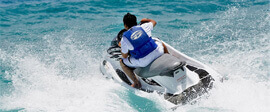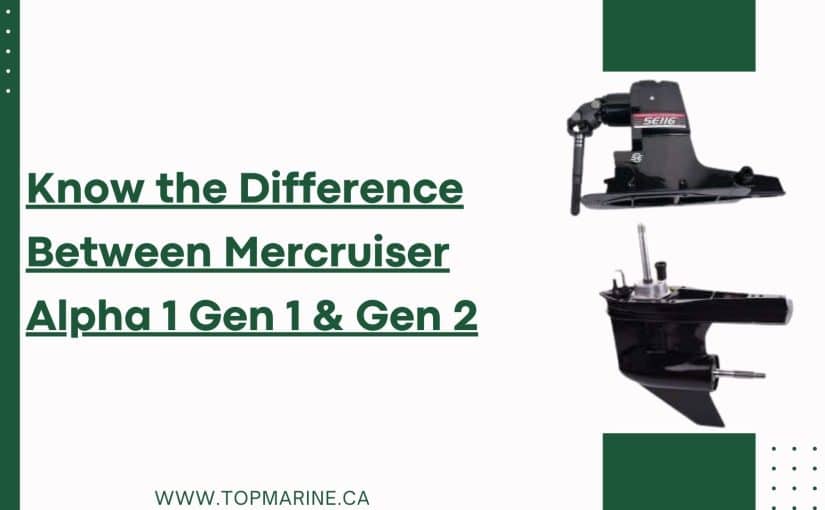Choosing the right outdrive for your boat is crucial for optimal performance and longevity. Mercruiser Alpha Generation 1, launched in the early 1980s, established itself as a reliable and cost-effective choice. Over time, advancements led to the development of the Mercruiser Alpha Generation 2.
This newer model boasts significant improvements in design and materials. Enhanced durability, better water flow, and easier maintenance are key features of Gen 2. Boaters often prefer Gen 2 for its upgraded performance and longer lifespan. Understanding these differences helps you make an informed decision for your marine needs.
Can you interchange the drive units of Alpha One Gen 1 and Gen 2?
The drive units of Alpha One Gen 1 and Gen 2 are not interchangeable. The Gen 2 was redesigned to improve performance, so its components are specific to its design. Using the wrong drive unit can cause mechanical issues and diminish the drive’s overall functionality.

Overview of Mercruiser Alpha Generation 1
The Mercruiser Alpha Generation 1, introduced in the 1970s to 1991, set a standard for recreational boating sterndrives. This model became popular due to its affordability.
Key Features:
- Gear Ratio: The Alpha Gen 1 typically uses a 1.94:1 or 1.47:1 gear ratio, providing decent acceleration and top speed performance.
- Shift Mechanism: Features a cable shift system known for its durability.
- Cooling System: Equipped with a raw water cooling system, it includes an impeller that pumps water from the lake or sea.
Construction:
The Alpha Gen 1 has an aluminum casing, which makes it lightweight and resistant to corrosion. The design is compact, allowing for easy maintenance and repairs.
Performance:
It offers reliable performance for small to mid-sized boats. Many boat owners appreciate its sturdy build and consistent operation over the years.
Maintenance:
Regular maintenance includes checking the gimbal bearing, u-joints, and water pump. Parts are widely available, making it easy to find replacements when needed. Fluids should be changed annually to prevent corrosion and damage.
Overview of Mercruiser Alpha Generation 2
The Mercruiser Alpha Generation 2 offers several improvements over its predecessor. Introduced in 1991, this model boasts enhanced efficiency and reliability.
Key Features:
- Improved Fuel Economy: Alpha Gen 2 is designed for better fuel efficiency, helping boaters save on fuel costs. The design changes reduce drag and improve overall performance.
- Redesigned Shift Mechanism: The shift mechanism is easier to handle, allowing for smoother transitions between gears. This makes the boat more responsive and easier to control.
Structural Differences:
- Shift Lever: One noticeable difference is the shift lever, which has been redesigned for better durability and operation. This is a visible change that users can identify.
- Gear Ratio: The Alpha Gen 2 introduced a 2.0:1 gear ratio, which replaced the older 1.94:1 ratio. This adjustment helps in better handling and performance at various speeds.
Maintenance and Parts:
When ordering parts for the Alpha Gen 2, it is important to note the changes in design. Parts like the gimbal bearing and impeller kits are different compared to the Gen 1. Ensure compatibility to avoid installation issues.
All the tools and parts for the Mercruiser Sterndrive can be found in topmarine.ca
The Mercruiser Alpha Generation 2 stands out for its efficiency, durability, and user-friendly features. These enhancements make it a preferred choice for many boaters who seek reliable and efficient performance.
Comparison Overview
From Gen 1 To Gen 2: What Changed?
The Alpha Generation 1, launched in the 1970s, was known for its strong and durable construction. However, there was room for improvement. To meet the demand for a more efficient drive, the Alpha Generation 2 was developed.
| Feature | Alpha Gen 1 | Alpha Gen 2 |
| Design | Simpler | More streamlined |
| Gear Lube Monitor Bottle | Missing | Present |
| Water Pump Durability | High | Higher |
| Trim Cylinder | Held on with nuts | Connected to Outdrive via C-clips |
| Trim Ram Mount | Far from the rear, attached with a nut | A few inches from the rear, attached with an e-clip |
| Lower Edge | Vertical skeg with a soft edge | Slanted skeg with a pointed edge |
| Maintenance | Moderate | Lower |
| Performance | Great | Improved |
Comparing Physical Structures
The Alpha Gen 1 has a more basic design. It uses fewer parts and simpler components. This makes it easier to maintain but limits its capabilities. The Alpha Gen 2 features a more advanced structure. It includes better materials and refined engineering. This results in improved durability and performance.
| Feature | Alpha Gen 1 | Alpha Gen 2 |
| Materials | Basic metals | Advanced alloys |
| Number of Parts | Fewer | More, but more efficient |
| Design Complexity | Simpler | More complex but better engineered |
Ease Of Installation
Installing both Mercruiser Alpha Generation 1 and Generation 2 is straightforward. Here is a comparison:
| Aspect | Alpha Generation 1 | Alpha Generation 2 |
| Weight | Light | Moderate |
| Tools Required | Basic Tools | Basic Tools |
| Time | 1-2 hours | 2-3 hours |
Common Issues And Troubleshooting
Both the Mercruiser Alpha Generation 1 and Mercruiser Alpha Generation 2 are popular sterndrives. Each has its own set of issues. This section will help you identify and troubleshoot common problems. We will look at typical issues for both generations.
| Issue | Gen 1 | Gen 2 |
| Water Intrusion | Common | Less Common |
| Shift Cable Issues | Frequent | Rare |
| Corrosion | High | Moderate |
| Gimbal Bearing Failure | Less Common | Common |
| Water Pump Issues | Rare | Frequent |
| Propeller Shaft Seal Leaks | Rare | Frequent |
Design and Construction
The Mercruiser Alpha Generation 1 and Alpha Generation 2 have several differences in their design and construction. These include changes in materials, gear ratios, and transom assemblies, which impact their performance and durability.
Material Improvements
In the Alpha Generation 2, Mercruiser made noticeable improvements in materials. For instance, they utilized more corrosion-resistant alloys. This improvement helps extend the lifespan of the stern drive, particularly in saltwater environments. They also enhanced the
construction of seals and gaskets to minimize water intrusion. This reduces maintenance needs. Improved bearings and gears are used in the Generation 2, These improvements lead to better reliability and smoother operation compared to its predecessor.
Gear Ratio Options
Mercruiser introduced different gear ratios in the Alpha Generation 2 that were not available in the Generation 1. The Generation 2 can come with a 2.0:1 gear ratio, which replaced the previous 1.94:1 ratio. This change offers better torque and higher efficiency for various boat sizes and applications. The variety of gear ratios 1.47 to 1.94 makes the Generation 2 more adaptable for different performance needs. Whether for increased speed or enhanced power, the Generation 2 caters to a range of boating requirements
Transom Assemblies
The transom assembly of the Alpha Generation 2 features significant upgrades over the Generation 1. The Generation 2 is built stronger to handle heavier and more powerful engines. It also has better gimbal rings and housings, making it structural overall. The shift linkage in the Generation 2 is designed for smoother and more precise shifts, reducing the likelihood of mechanical issues common in the Generation 1. This makes it a better choice for heavy use.
For more detailed comparisons, you can refer to the comprehensive analysis on Alpha One Generation 1 vs Generation 2.
Performance Comparisons
The Mercruiser Alpha Gen 1 and Gen 2 models have key differences in acceleration, fuel efficiency, and handling. These changes are made to make using the water more enjoyable for everyone.
Acceleration and Top Speed
The Alpha Gen 2 features a redesigned gear ratio which improves acceleration. This is crucial for activities like water skiing or towing where quick starts are important.
Top speed capabilities are also slightly better in the Gen 2, attributed to its efficient power transfer. People who want to maximize performance are a better choice for them. The smoother gear shifts in the Gen 2 also contribute to a seamless acceleration experience, reducing the wear and tear on the engine over time.
Fuel Efficiency
Fuel economy is a major upgrade in the Alpha Gen 2 compared to the Gen 1. It offers better fuel consumption rates, helping boaters save money on long trips.
The improved efficiency comes from an optimized design that reduces drag and increases propulsion. This means less fuel is used to achieve the same distance, which is beneficial for both budget and environmental concerns. The enhanced water pump in the Gen 2 also contributes to better overall performance.
Handling Characteristics
Handling improvements are noticeable in the Alpha Gen 2. It features better u-joints and bellows, which provide superior control over the boat.
The Gen 2’s redesigned shift mechanism also makes it easier to maneuver, particularly in tight spots. Boaters will find the steering response quicker and more precise, making it ideal for both leisurely cruises and high-speed adventures. Enhanced sealing to protect the gears further ensures reliable performance and longevity.
Durability and Maintenance
The Mercruiser Alpha Generation 1 and Generation 2 outdrives have notable differences in their durability and maintenance requirements. Important things to think about are how quickly it wears out, how easy it is to fix, and if you can find new parts when needed.
The Mercruiser Alpha Gen 2 is an improvement over the Gen 1 in terms of durability. It has stronger U-joints and bellows that don’t wear out easily. These parts need fewer repairs and make the drive last longer.
In comparison, the Gen 1 models typically experience more frequent issues with components such as seals and gears. This can cause more breaks and make fixing things cost more. Additionally, the Gen 2 has better sealing in the upper gear case, which helps prevent damage to the driven gear if there’s a seal failure.
Wear and Tear
The Mercruiser Alpha Gen 2 is an improvement over the Gen 1 in terms of durability. It features enhanced U-joints and bellows, which are more resistant to wear. These parts help in reducing the frequency of repairs and extending the lifespan of the drive.
In comparison, the Gen 1 models typically experience more frequent issues with components such as seals and gears. This can cause more breaks and higher repair costs. Additionally, the Gen 2 has better sealing in the upper gear case, which helps prevent damage to the driven gear if there’s a seal failure.
Ease of Service
Servicing the Alpha Gen 2 is relatively easier due to its improved design. The Gen 2 has a shift lever design that makes it easier to access and maintain. This results in less time spent on routine maintenance and repairs.
The Gen 1, on the other hand, has a more complex mechanism that can be harder to work on. This complexity often requires more specialized tools and knowledge for proper servicing. Boaters may find repairing or replacing parts on the Gen 1 to be more cumbersome and time-consuming.
Availability of Replacement Parts
Finding replacement parts for both models is generally straightforward, but there are differences. Parts for the Gen 2 are more readily available due to its improved design and popularity. Manufacturers keep making many different parts that work together. This makes it easy to find what you need without any trouble.
Gen 1 parts can still be found but may not be as abundant. As these models age, the production of certain parts has slowed down. This might require boat owners to seek out specialty suppliers or consider aftermarket options, which could be less reliable in quality.
Installation and Compatibility
When considering the Mercruiser Alpha Generation 1 and Generation 2, installation and compatibility are key concerns. This section covers the engine compatibility and the types of boats each generation suits best.
Engine Compatibility
The Mercruiser Alpha Generation 1 is compatible with engines from the early 1970s until 1990. After 1991, the Generation 2 became the standard. The Alpha Gen 2 offers improvements like better U-joints, sealing, and gear ratios.
When upgrading from Gen 1 to Gen 2, ensure that the engine mount and coupling are compatible. Sometimes, minor adjustments to the transom assembly may be required. Compatibility issues might arise if you don’t check these aspects before the installation.
Boat Types and Sizes
The Alpha Gen 1 is often found in older boats, typically those built before 1991. It suits smaller recreational boats and works well with engines up to around 300 horsepower. It’s popular in models like the Sea Ray 175.
The Alpha Gen 2, with its structural improvements, is better for larger boats and those needing more power. It fits well in modern designs and larger recreational boats or small yachts. Gen 2 is often selected for its durability and better performance in more demanding boating conditions.
Technological Advancements
The Mercruiser Alpha Generation 2 has several notable technological improvements over the Alpha Generation 1. Key advancements include a redesigned shift system and a more efficient water pump.
Shift System Improvements
One significant advancement in the Alpha Generation 2 is the shift lever design. Unlike the Alpha Generation 1, which uses a mechanical shift lever, the Generation 2 features an improved system that offers smoother and more precise shifting. This change reduces the noise and the amount of force needed to engage gears, enhancing user experience significantly.
In addition, the Generation 2 model incorporates wear pads on the shift slide. These pads extend the life of the components and decrease maintenance requirements. The refined shift mechanism also improves the overall reliability of the drive system.
Water Pump Design
Another crucial technological advancement is the water pump design. The Alpha Generation 2 features an upgraded water pump that provides better cooling performance. It uses a more efficient impeller design, which increases water flow and enhances cooling efficiency. This improvement is particularly beneficial for preventing engine overheating under heavy loads.
In the Generation 1 model, maintenance of the water pump can be more frequent due to its design. The Generation 2’s pump is easier to access and service, saving time and reducing the potential for operational issues. This makes the Alpha Generation 2 a more reliable option for boat owners who value minimal maintenance and high performance.
Cost Analysis
Comparing the costs between Mercruiser Alpha Generation 1 and Generation 2 requires focusing on initial purchase costs and long-term maintenance considerations.
Initial Purchase Cost
The initial purchase cost can vary significantly between the two models. The Alpha Generation 1 is typically cheaper, often due to its older design and simpler features. Boaters on a budget might prefer this model for its affordability.
In contrast, the Alpha Generation 2 is generally more expensive. The higher cost is justified by enhanced features such as improved fuel efficiency and ease of shifting. These advancements can offer better value over time even though the upfront cost is higher.
Long-Term Costs
When considering long-term costs, it’s important to look beyond just the initial price tag. The Alpha Generation 2 has several improvements that can lead to savings in the long run. For instance, its advanced fuel economy can reduce fuel expenses. Additionally, it has a redesigned shift mechanism that minimizes wear and tear, potentially lowering maintenance costs.
The Alpha Generation 1, while cheaper upfront, may incur higher long-term expenses. Its older technology can mean more frequent repairs and replacements. For example, the impeller in Gen 2 is larger and more durable than in the older models, leading to fewer replacements and less downtime for maintenance.
By looking at both the starting costs and the long-term costs, boaters can choose the best boat for their needs and budget.
Key Comparisons
| Feature | Alpha Gen 1 | Alpha Gen 2 |
| Drive Oil Capacity | 32 oz | 38 oz |
| Water Pump Location | Upper unit | Lower unit |
| Gear Ratio Options | Several | More options |
| Shift Mechanism | Mechanical | Improved mechanical |
Alpha Gen 2 offers increased oil capacity. This improves lubrication. Its water pump is located in the lower unit. This enhances cooling efficiency. Alpha Gen 2 also offers more gear ratio options. This provides better performance across different boating needs. The shift mechanism in Gen 2 is more refined.
Both drives have their strengths. Choosing between them depends on specific needs. Knowing these differences helps make a better choice.
User Experiences and Reviews
Many users prefer the Mercruiser Alpha One Gen 2 for its improved performance. Its redesigned shift mechanism makes it easier to shift compared to Gen 1. The improved fuel economy is another benefit highlighted by users. They often mention saving money in the long run due to these enhancements.
In terms of durability, users report that the Gen 2 has better u-joints and bellows, preventing frequent maintenance issues. The larger and more durable impeller in the Gen 2 is noted for its longevity, especially in rough conditions.
Some boaters appreciate the Alpha One Gen 1 for its cost-effectiveness. It’s generally cheaper, making it a good option for those on a budget. However, they often accept that the Gen 2 offers superior structural and functional advantages.
Common advantages of Gen 2 noted by users include:
- Improved gear ratios
- Better sealing in the upper drive
- A low lube warning alarm
These features are frequently praised for preventing potential failures and extending the life of the drive.
While performance and reliability are the main highlights of the Gen 2, the Gen 1’s affordability continues to attract those prioritizing budget over features. This blend of user feedback helps potential buyers make informed decisions.
Warranty and Support
Warranty and support are vital considerations for anyone choosing between Mercruiser Alpha Generation 1 and Generation 2 stern drives.
Warranty Coverage:
Both the Gen 1 and Gen 2 typically come with a limited warranty from Mercruiser. For Gen 1 models, the warranty offered in the past was usually shorter. In contrast, the Gen 2 models often come with longer and more comprehensive warranties.
Support Services:
Mercruiser provides extensive support services, which include:
- Technical Support: Both models benefit from Mercruiser’s large network of dealers and authorized service centers.
- Repair Services: Gen 2 owners might have an edge due to extended parts availability and improved service protocols.
- Documentation: Detailed manuals and online resources are available for both generations.
Availability of Parts:
The Gen 1 might face limited parts availability due to its age. Finding components for repairs could be challenging as the focus has shifted to the Gen 2. The Gen 2 has the advantage of more readily available parts and ongoing support from manufacturers.
Extended Warranties and Upgrades:
Owners of Gen 2 models can often purchase extended warranty packages. These packages provide additional peace of mind. Some older Gen 1 models might not have such options available.
Warranty Comparison:
| Feature | Gen 1 | Gen 2 |
| Standard Warranty | Shorter | Longer |
| Extended Warranty | Limited | Often Available |
| Parts Availability | Decreasing | Readily Available |
Choosing between the Mercruiser Alpha Gen 1 and Gen 2 in terms of warranty and support depends on individual needs and priorities.
Last Words & Recommendations
Both Gen 1 and Gen 2 offer reliable performance. Your choice depends on your specific needs, budget and boating needs. The Gen 1 is appreciated for its affordability and durability, while the Gen 2 offers enhanced efficiency, performance, and maneuverability.
Choosing between the two models depends on your specific needs and budget. Proper maintenance and repair are crucial for ensuring optimal performance and longevity of your Mercruiser Alpha One. For those seeking to improve performance, it’s advisable to research and consult with a certified Mercruiser technician before considering aftermarket upgrades.
Understanding the differences between Gen 1 and Gen 2, and maintaining your drive properly, will ensure years of reliable and efficient boating. Both models provide quality and reliability for an enjoyable boating experience.
Frequently Asked Questions
What Is The Difference Between Alpha 1 And Alpha 2?
The main difference is in design and performance. Alpha 2 has a more robust design and improved shifting mechanism. It also offers better corrosion resistance and overall durability compared to Alpha 1.
Which Is More Durable, Alpha 1 Or Alpha 2?
Alpha 2 is more durable. It features an improved design and better materials. This makes it more resistant to wear and tear, offering a longer lifespan.
Can I Upgrade From Alpha 1 To Alpha 2?
Yes, you can upgrade. However, it requires compatibility checks and possibly additional modifications. Consult your marine mechanic for a precise evaluation and advice on the upgrade process.
Is Alpha 2 Faster Than Alpha 1?
Alpha 2 can offer better performance. Its improved design and smoother shifting can potentially lead to higher speeds. However, actual speed gains depend on various factors, including the boat and engine.
What technical improvements were made in the Alpha One Generation 2 compared to Generation 1?
The Gen 2 model includes several technical upgrades. It has improved sealing in the upper unit, better gear ratios, and an alarm on the lube bottle to prevent failures due to low lubricant levels. These enhancements result in better durability and performance.
Can you interchange the drive units of Alpha One Gen 1 and Gen 2?
The drive units of Alpha One Gen 1 and Gen 2 are not interchangeable. The Gen 2 was redesigned to improve performance, so its components are specific to its design. Using the wrong drive unit can cause mechanical issues and diminish the drive’s overall functionality.






